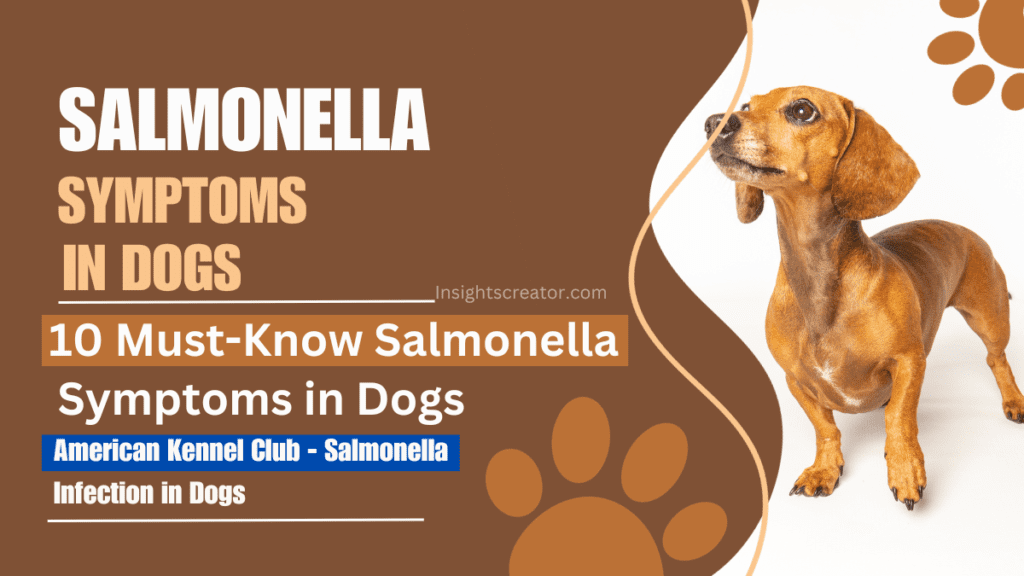Contents
10 Must-Know Salmonella Symptoms in Dogs
Salmonella Symptoms : Salmonella is a dangerous bacterial infection that can affect not only humans but also our beloved canine companions. As responsible pet owners, it is crucial to be aware of the signs and symptoms of this illness in dogs. By recognizing these symptoms early on, we can seek appropriate veterinary care and help our furry friends recover quickly. In this article, we will discuss the ten must-know salmonella symptoms in dogs to ensure their well-being and prevent further complications.

1. Diarrhea
One of the most common and noticeable symptoms of salmonella in dogs is diarrhea. The diarrhea caused by salmonella may be more severe than regular episodes and can persist for an extended period. It is typically watery, may contain mucus or blood, and have a foul odor. Keep an eye on your dog’s stool consistency and consult a veterinarian if you notice any abnormal changes.
You May Also Read Thanksgiving: Top 5 Ways to Celebrate Thanksgiving
Sub-point: Dehydration Risk
Diarrhea can lead to dehydration in dogs, so it’s essential to monitor their water intake. If you observe signs such as excessive thirst, dry gums, or lethargy, seek immediate veterinary attention.
2. Vomiting
Alongside diarrhea, dogs infected with salmonella may experience vomiting. Although occasional vomiting can be normal for dogs, persistent and forceful vomiting should raise concerns. If your dog vomits excessively or shows signs of discomfort, it is crucial to consult a veterinarian for a thorough examination.
3. Loss of Appetite
Salmonella infection can significantly impact a dog’s appetite. If you notice that your dog is refusing food or showing disinterest in meals, it might indicate an underlying health issue, including salmonella. Observe any changes in eating habits and seek advice from a veterinary professional if appetite loss persists.
4. Fever
Fever is a common sign of infection in both humans and dogs. An elevated body temperature is the body’s defense mechanism in response to an infection. If your dog feels warm to the touch or is displaying symptoms of illness along with a high temperature, it is essential to consult a veterinarian promptly.
“Monitoring your dog’s temperature is crucial for early detection of illness.” – Dr. Smith, DVM.
5. Lethargy and Weakness
Dogs infected with salmonella often experience lethargy and weakness. They may seem tired or less energetic than usual. If your dog is unusually inactive, reluctant to play, or exhibits signs of fatigue, it could be an indication of an underlying health issue, including salmonella infection.

6. Abdominal Pain
Salmonella infections can cause abdominal pain in dogs. This pain can manifest as restlessness, whimpering, or a hunched posture. If you notice your dog showing signs of discomfort or pain in the abdominal area, it is essential to consult with a veterinarian to assess the situation properly.
7. Weight Loss
Unexplained weight loss is a concerning symptom in dogs and can be associated with various health conditions, including salmonella infections. If your dog is losing weight rapidly without any changes in diet or exercise routine, it is crucial to seek veterinary advice to identify the underlying cause and provide appropriate treatment.
8. Increased Thirst and Urination
Salmonella infections in dogs can disrupt their normal drinking and urination patterns. If you observe that your dog is drinking more water than usual or needing to urinate more frequently, it could be a sign of a health issue. Monitoring these changes and seeking veterinary attention can help in early diagnosis and treatment.
9. Respiratory Symptoms
In some cases, dogs infected with salmonella may exhibit respiratory symptoms such as coughing, sneezing, or difficulty breathing. While respiratory symptoms are less common compared to other signs, it is essential to be aware of these potential indications to ensure prompt medical intervention if necessary.
10. Blood in Stool or Urine
The presence of blood in your dog’s stool or urine can indicate a severe salmonella infection. Blood in stool may appear as red streaks or a tarry, black color. If you notice any signs of blood in your dog’s excretions, it is crucial to contact your veterinarian immediately for proper evaluation and treatment.
Note: If you suspect salmonella infection in your dog, it is crucial to handle their waste carefully, as it can transmit the bacteria to humans and other animals.
Remember, early detection and prompt veterinary care are crucial for the well-being of your furry friend. If you observe any of the mentioned symptoms or suspect salmonella infection, consult your veterinarian for an accurate diagnosis and appropriate treatment.

+External resources:

